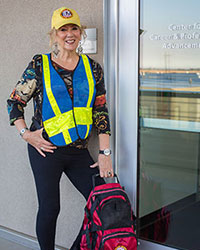
 During most weekdays, you’ll find Student Employment Coordinator Phyllis Enea in the Center for Professional and Career Advancement, assisting students and training managers throughout the hiring process.
During most weekdays, you’ll find Student Employment Coordinator Phyllis Enea in the Center for Professional and Career Advancement, assisting students and training managers throughout the hiring process.
In the event of an emergency on campus, however, Enea would spring into action as a building safety coordinator to help secure the second floor of the Student Services Building. Enea, who was recruited for the volunteer program six years ago, joined because she knows how vital the building safety coordinator’s role is.
“My main concern is the safety of students and employees — making sure they are removed from places of danger,” she said. “I would report directly to first responders of all cleared areas or anyone still remaining in their office.”
Tamela Adkins, support services manager and emergency manager for campus police services, started UC Merced’s Building Safety Coordinator (BSC) program in 2011. Any member of the campus community can volunteer for the program. The only requirements are a working knowledge of department and work areas, being able to coordinate any safety related information with department members, and attending training.
Enea has participated in several trainings, including a two-day Emergency Management Institute program through the Federal Emergency Management Agency and one on how to respond should there be a fire in a building.
“We were taken on a building tour to learn where the fire extinguishers were located and shown the safest places to bring people during a fire,” Enea said. “We were also instructed how to secure the office fire doors.”
Drills are an important part of keeping building safety coordinators active in their roles. During the “Great California ShakeOut” drill on Oct. 15, many of the campus’s 75 building safety coordinators suited up in their blue vests and yellow hats, and talked with colleagues on their floors or within their areas about exits and the evacuation assembly areas for their buildings. Some took the exercise a step further and evacuated their areas.
“Participating in exercises allows the campus to assess its capabilities and plans, and it enables Emergency Operations Center staff, emergency responders and building safety coordinators to put their training into practice,” Adkins said. “The campus benefits from lessons learned to make UC Merced more resilient when an emergency or disaster strikes.”
For Enea, participating in drills has demonstrated the building safety coordinators’ readiness to assist during a campus crisis.
“With continued training, I know that if there is an emergency on campus the building safety coordinators will do a great job in assisting first responders,” she said.
For information about the Building Safety Coordinator program or to volunteer, email Tamela Adkins at tadkins@ucmerced.edu. Review additional emergency preparedness resources, including the campus’s emergency operations plan, online at emergency.ucmerced.edu.
Brenda Ortiz

Senior Public Information Representative
Office: (209) 228-4203
Mobile: (209) 628-8263






